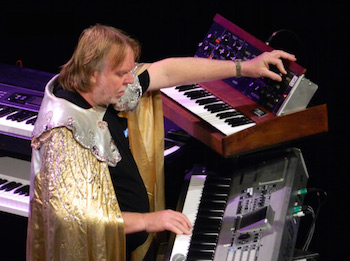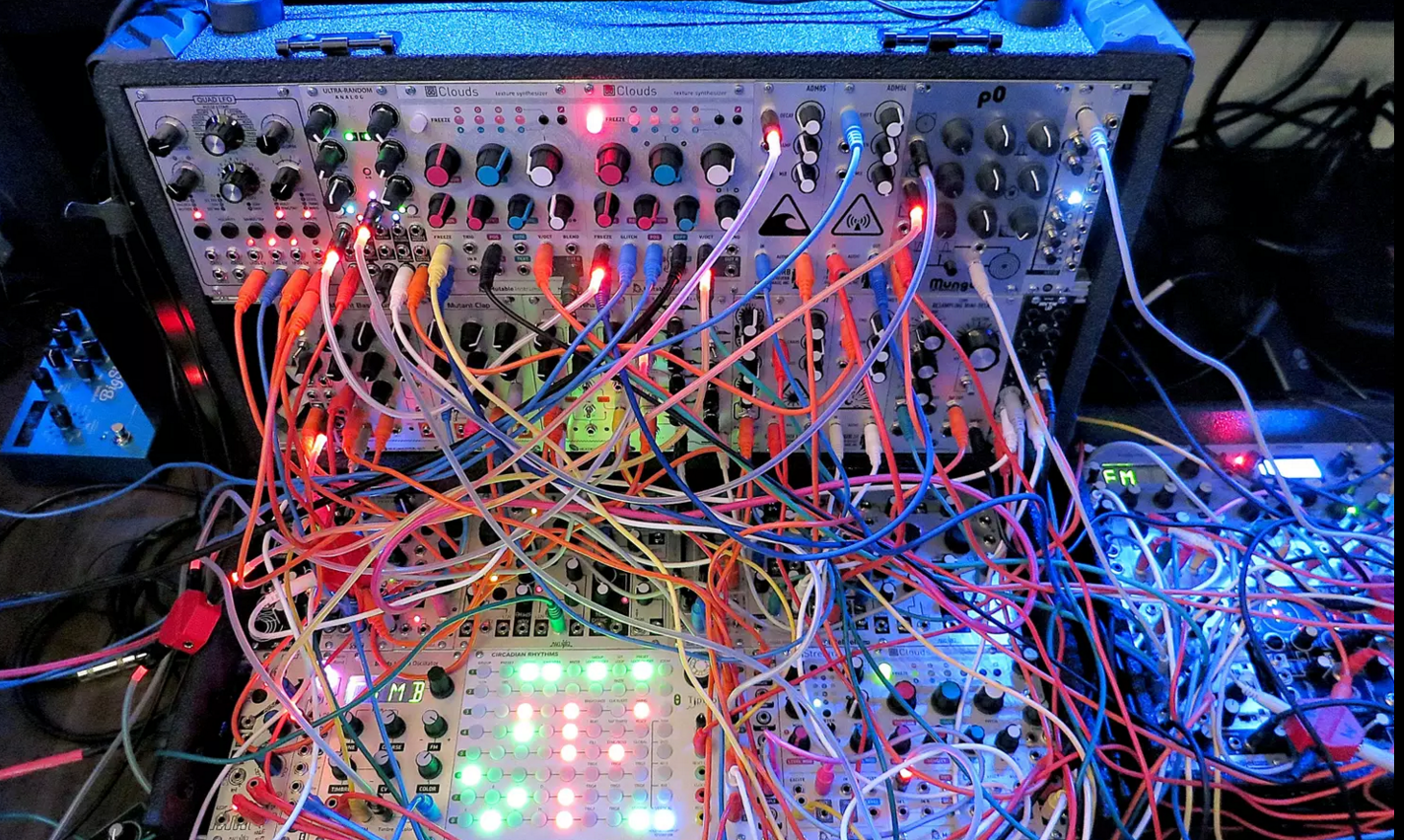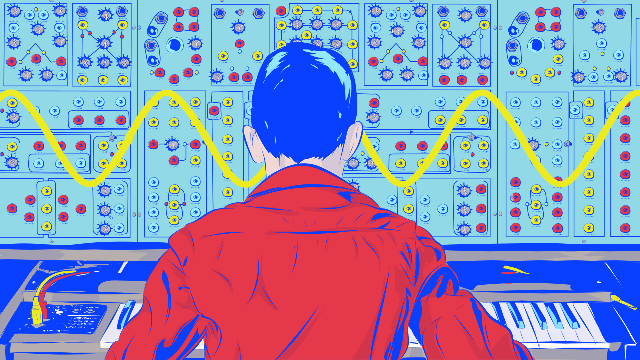You know the sound. Listen to Devo’s “Whip It” or Parliament’s “Flash Light.” Like countless modern pop songs, they’re full of sounds that aren’t made by acoustic instruments; the sound is pure synthetic. You’re listening to electricity manipulated by a machine.
The machine of course is the synthesiser, and it’s been one of the most crucial building blocks of contemporary music. And yet, how many of us know how a synth works? How do a bunch of wonky tones coming out of a box covered in knobs and buttons translate to the memorable sounds of disco, or synthpop, or house or electro or EDM or Taylor Swift?
This guide is an attempt to demystify the ubiquitous sonic gadget — not for audiophiles or synth nerds, but for anyone that listens to music in the 21st century and is curious about how it’s made.
Creating Sound From Scratch
Let’s start at the beginning, 50 years ago, when an electrician (not a musician!) named Robert Moog devised a new way to make sound: using an electrical signal.
On the heels of the invention of the transistor, Moog (rhymes with “vogue”) made a machine that could break sound down into its most fundamental properties and control every aspect of it with voltage — essentially building sound from scratch.
Which is why to really understand anything about synths, you have to have a basic grasp of acoustic theory. So let’s go back to physics class a second.
In a nutshell, sound is caused by a vibrating object creating changes in air pressure, which vibrates our eardrum, and which we in turn perceive as sound. A synthesiser basically mimics this natural acoustic process. So instead of a plucked, vibrating guitar string, the vibration — called “oscillation” in synthspeak — comes from an electrical signal generated by rapidly changing voltages in a circuit.
Those oscillations repeat periodically, in patterns called waveforms. And every aspect of a waveform — its size, speed, structure — can be further shaped by the synth’s controls to carve out a sound’s pitch, timbre, tone and more. Then eventually, the electrical signal is amplified and sent through a speaker to convert it back to sound the human ear understands.
Now in the beginning, synths weren’t musical in the traditional sense — they were pretty much crap at emulating acoustic instruments in any realistic way, because the waveforms produced by organic sounds are much more complex and harmonically rich (more on this later) than the precise mathematical waves generated by electricity. But synths were very good at spitting out trippy, otherworldly sounds that don’t exist in nature at all, which is why they found a perfect early home in 60s psychedelia and scifi films.
But how does an electrical signal go from sounding like the robotic fart sound of speaker feedback into something resembling music? Here’s where all those knobs come in.
How a Synthesiser Works

The control panel on the Minimoog synthesiser
All synths have a few basic components that work together to forge a sound: an oscillator that generates the waveform and changes its pitch, a filter that carves out certain frequencies in the wave to change the timbre, an amplifier that controls the signal volume, and modulation to create effects. Let’s break those down a bit.
Oscillator
The oscillator is the initial source of the sound — like the guitar string pluck. Voltage from a power source oscillates electrons which generates a waveform, and most synths let you select from various types of waves because different patterns have different sounds. The most common types are:

Fundamentals of synthesis poster via Moog Foundation
Hear the difference in their sounds:
The synth’s oscillator section also controls pitch, or in physics-speak, frequency. Frequency is the speed of the vibration (the frequency with which a waveform completes one cycle of its pattern). It’s measured in cycles per second, or Hertz. The faster the frequency, the higher the pitch — double the frequency and the pitch goes up an octave.
So to put it in musical terms, a 440 Hz tone is an A note, and 880 Hz is an A an octave up. 260 Hz is middle C and so on. Maths! (The human ear can hear as low as 20 Hz and up to 20 kHz, which you might notice is the name of this here blog.)
Filter
So that’s how you get different notes to play a melody. But a trumpet and piano sound very different even when played at the same pitch, because of the sound’s timbre. This is where the synth starts messing around with harmonics.
A sine wave is just one single frequency, but all other sounds are made up of several frequencies that combine to form the dominant pitch that you hear. It’s why a C chord on the guitar sounds like a C even though E and G notes are also played. These are called harmonics; they aren’t heard as discrete pitches, but rather overtones that gives a sound its unique character or timbre.
The filter section of a synthesiser modifies timbre by blocking certain frequencies in the waveform and letting others through. Turning the filter knob from top to bottom gives you this recognisable sound:
The Moog synthesiser in particular is famous for its rich filter sounds (and even patented one of them). You can actually hear that classic Moog analogue filter in the opening track of Kanye West’s Yeezus, a track produced by Daft Punk:
Amplifier and Envelope Generator
Beyond speed, a synth can also manipulate the signal’s size, and here’s where the amplifier comes in. As you know the amp controls volume by making a signal bigger and thus louder. But it can also modify the amplitude of the signal over time — how quickly it reaches peak loudness, and how long it sustains that volume. Think about the difference between the staccato sound you get from banging a piano key versus the gradual lead-up of the sound of a violin string.
This loudness contour can be controlled by a synth’s “envelope generator.” The most common is called ADSR, for attack (the onset of the sound), decay (when it starts to fade), sustain (how long the sound holds), and release (when it ends). Adjusting this contour can significantly change the character of a sound.
Modulation
There are many other modulators that further mess with these sonic properties. One standby is the low-frequency oscillator or LFO. It oscillates a signal at very low frequencies, lower than the ear can hear, so it’s not used to create sound but to modulate other parts of the synth for effects like a wah pedal. When applied to the oscillator, it wiggles the pitch to create vibrato. Applied to the amplitude makes the volume go up and down creating tremolo. Appying it to the filter is how you get the signature dubstep wobble bass:
A ring modulator is another popular effect that works by combining two signal inputs to get brand new frequencies. It makes a wobbly metallic sound — the effect behind the classic eerie synth sound behind the Doctor Who soundtrack and the voices of the Daleks. Exterminate.
The most common form of synthesis — the kind Dr. Moog pio is called subtractive synthesis — it starts with a harmonically rich waveform and filters out certain frequencies to carve out a sound. (Ali Jamieson’s blog post “Forgive me Lord for I Have Synth” is a great guide).
But as synths advanced, they starting using other kinds of audio synthesis that could add or multiply waves together, and the range of possible sounds exploded. Synths got much better at mimicking traditional instruments including percussive sounds like bells and drums, which led to the eruption of dance music.
Synths went from being a novelty effect used to spice up rock songs to the primary ingredient in a track, eventually replacing traditional instruments altogether. Let’s take a quick little tour through history.
Evolution of the Synth

The legendary Yamaha DX7, the sound of plasticky 80s synthpop
As the technology behind synths matured, it took popular culture right along with it. Think about the music that defined the last five centuries and you can basically hear the machine evolve. Through the 70s and 80s, a new model design or the latest high-tech feature opened up the potential for sounds that had never been created before — you could build a song around these novel sounds (Synthtopia has a fun list of famous synth sounds). Some even spawned entire musical subgenres.
The first synths were called modular synthesizers, because each component — oscillator, filter, etc — were separate modules that you had to manually connect by plugging wires (called patch cables) in and out of different parts of the machine. They were massive, cumbersome, and expensive as fuck, and mostly relegated to university sound labs.
But some successful artists could afford to experiment with the cutting-edge machines, namely pop stars like the Monkees, on “Daily Nightly” in 1967; four tracks of the Beatles’ Abbey Road including “Maxwell’s Silver Hammer,” (0:58) and “Here Comes The Sun” (1:40); and prog rocker Keith Emerson who’s famous for dragging his massive modular onto the stage to show it off.
Keith Emerson’s 1970 single “Lucky Man” is considered the first ever synth solo
But the watershed moment for early modular synths was Donna Summer’s disco hit “I Feel Love,” produced in 1977 by Georgio Moroder, who as the Guardian describes it “pulled the voice of God from the void. Everything that isn’t the kick drum or Donna Summer are the big-brained dreams of a Moog modular.”
(I’d be remiss not to mention that while Moog mainstreamed the instrument, Don Buchla invented his modular synth at the same time on the West Coast, where the sound was more avant-garde. Silver Apples of the Moon, composed by Morton Subotnick on the Buchla, was the first electronic music sold by a record company.)
The synth really took off in the early 70s when the tech got more compact, and portable all-in-one synths like the Minimoog came out. These fancy new synths were internally hardwired — no messy patch chords — and musicians could take them on tour and play them on stage.

Everyone started incorporating synths into their music; you can hear it in 70s songs across genres: pop, funk, glam rock, reggae, jazz, new wave and most notoriously prog rockers in sequenced capes. “When you think of how an analogue synthesiser is supposed to sound, you’re probably thinking of a Minimoog,” The Vinyl Factory wrote. “The thick, bassy throbs that have come to characterise the instrument over the last four-and-a-half decades.”
And electronic music became popular as its own genre. Pioneer synth composer Wendy Carlos’s record Switched-on Bach sold half a million copies and won three Grammys in 1968, and six years later, the German band Kraftwerk came out with Autobahn, the record generally credited with spawning electronic pop, and making machine music cool in its own right.
The Rise of Digital
At the very end of the 70s, digital synthesizers came along and revolutionised music. Replacing circuits with algorithms meant you could program waveforms stacked together in any combination to recreate almost any sound. Synths got (relatively) good at emulating organic instruments, and suddenly you could press a button and get “piano” or “bass” without any traditional musical skill.
And this is what the 80s sounded like.
Artists increasingly relied on the preset sounds (also called “voices” or “patches” after the patch cables on modular synths) that came factory ready, which is why so many 80s pop songs sound the same — no one (except for Brian Eno, of course) bothered to program their own sounds from scratch.
Those cheesy, plasticky patches on the legendary Yamaha DX7 — the first commercially available, mass-produced digital synth — are ubiquitous in 80s synthpop ballads. You surely know the sound well:
The Marimba patch was common in new wave — it’s the synthetic bass in A-Ha’s “Take on Me.” The flute, electric piano, and even harmonica solo on Tina Turner’s “What’s Love Got to Do With It” are made with DX7 patches, a trifecta of cheese salvaged only by Turner’s incredible voice.
The Korg M1 synth came out not long after the DX7 and sold millions. You can’t listen to 90s music without recognising the M1’s iconic voices — the slap bass voice in the Seinfeld theme, or the piano and organ presets that defined 90s house music, starting with Madonna’s “Vogue.”
Speaking of dance, the genesis of acid house is a fun example of the effect the evolving synth had on music. The now-famous Roland TB-303, which was actually one of the last analogue synths but had a simple intuitive sequencer great for four-on-the-floor beats, basically singlehandedly created the acid sound, on accident.
The 303 was designed to replace the bass player in a rock band but was too unpredictable and hard to program (it didn’t come with directions) so it sucked at it and flopped, causing young producers in Chicago’s underground house scene to pick up the discounted secondhand synths and started messing around. The squrity squelchy bass sound that came out of the erratic 303s was the sound of acid house. (Fatboy Slim’s track “Everybody Needs a 303” wasn’t hyperbole.)
Analogue Resurgence
But popular music follows a predictable cycle, always rebelling against the sound that came before it, causing a sonic 180. Just as punk almost killed synth music after disco (until new wave melded the punk ethos with the electronic sound), a backlash against the robotic plasticky homogenous sounds of 80s pop led to a trend toward “real” sounds in the mid-90s — most obviously with grunge, but also a return of analogue synths, heard in ambient music pioneered by Brian Eno, and 90s electronica like Prodigy, Chemical Brothers, and Aphex Twin.
The pendulum swung back again when the rise of super affordable software synths (“softsyths”) meant anyone with a laptop could be a producer or pump out EDM to dance floors at da club. And now, it’s swinging back again. Analogue synths are back in vogue — major brands like Moog, Roland, and Korg are capitalising on nostalgia by putting out revivals of vintage icons (“vintage” in synthspeak is anything before the 90s) like the ARP Odyssey and Roland Jupiter 8.
Analogue’s cool is only partly due to the sound — yeah, we tend to find the warm imperfection of analogue machinery more pleasing than the robotic precision of digital technology. But today the are “analogue modelling” digital synths that are good enough at mimicking the character of old-school imperfection the average ear probably can’t discern the origin of the sound.
The backlash against push-button laptop jockeys may be less about sound and more about creativity — the lack of inspiration you tend to get when choosing from a infinite library of packaged sounds that soft synths and so-called romplers cram inside a virtual box. People like hardware that you can pick up and play like an instrument, and there’s an enthusiastic subculture of indie boutique manufacturers designing unique and wacky hardware synths and modules.

A modular synth, via Richard Devine/Vimeo
Modular synths are also undergoing an undeniable resurgence (which the excellent documentary I Dream of Wires describes in detail). Purists love modulars because it forces you to think about the aspects of sound and not rely on presets, opening up the possibility of serendipitous sonic discoveries. Moving a cable or adding a new module to your rig can change the entire sound of the machine — so the possibilities are quite literally infinite, limited “only by your imagination,” the mantra goes.
Growing consensus is that this pivot back to modular synthesizers isn’t nostalgia, but more that we never actually explored the full sonic potential of these walls of colourful wires and blinking lights in the first place — that we tossed them aside too soon to jump on the high-tech bandwagon. The next chapter in the evolution of the synth could be to go back where it started. Maybe the golden era of of synthetic sound is actually ahead of us.
[Sources: Synthesiser Academy [Moog Foundation [Dean Friedman [Ali Jamieson [The Vinyl Factory; Guardian [Wikibooks [Synthmania [FACT [Sound on Sound [I Dream of Wires]]
Top illustration by Sam Woolley
